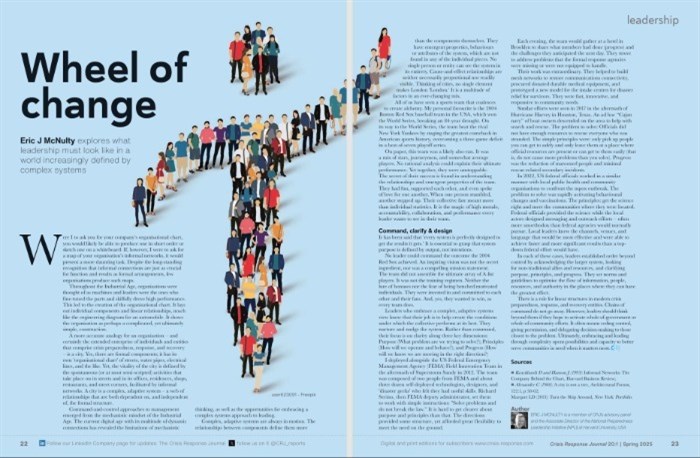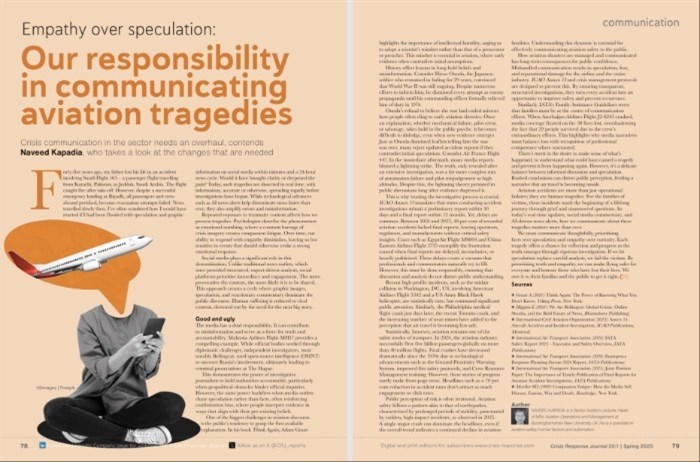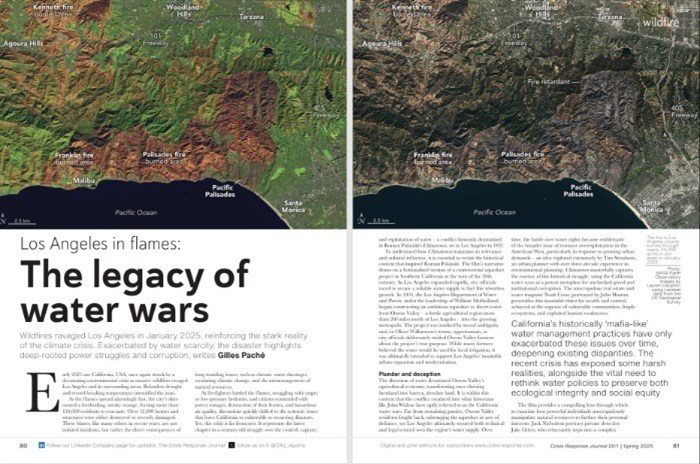CRJ Spring 2025 is out now!
 Our Spring 2025 issue is now live. The digital edition can be accessed on the CRJ website, whereas CRJ 20:1 hard copies will be mailed out shortly.
Our Spring 2025 issue is now live. The digital edition can be accessed on the CRJ website, whereas CRJ 20:1 hard copies will be mailed out shortly.
Looking into the theme of complex systems, this edition explores the dynamics of crisis management, highlighting interconnected, complex problems, evolving security threats, and the role of innovative tools in disaster response. It also examines the lessons learnt from past crises, the importance of proactive leadership, and the need for adaptive crisis communication strategies in an unpredictable world.
Comment: Matthew Porcelli explains why instilling a proactive security culture and leadership can allow organisations’ to better mitigate vulnerabilities and return to normal operations throughout the crisis process. On the other hand, Matt Minshall warns against potential global implications of declining democratic values when leadership is driven by self-serving interests.
Onto complex systems: Amanda Coleman discusses the turbulent start of 2025, marked by terrorist incidents, climate-related hazards, health crises, and plane crashes, emphasising the human influence on each of such situations and the real lives that have been affected beyond the headlines. Simultaneously, Dr Jennifer Hesterman explores the issues of insider threat and how private companies can learn from US Department of Defense’s (DoD) Insider Threat Program, examining cases such as Tesla, Discovery Bay, and the US Air National Guard.

Eric McNulty's piece on p22 takes on leadership in a complex world
Eric J McNulty emphasises the importance of informal networks in organisations, asking for leaders to move beyond command-and-control approaches to management. James Lodge suggests that in an era of interconnected risks and unpredictability, organisations should transcend static plans and checklists in favour of establishing dynamic skills to identify and respond to emerging disruptions with agility and resilience. Chris Cubbage highlights how space medicine innovations are transforming crisis response.
In terms of aviation security, Andy Blackwell and John Wood emphasise the role of Security Management Systems (SeMS) in addressing complexity by shifting the focus to proactive security behaviours rather than reactive, compliance-based ones.
Stephen Johnson reviews UK’s Covid-19 inquiry, assessing its strengths, shortcomings, and the government’s response to the recommendations. Meanwhile, Jacob Jefferies expands on how defence could outsource Chemical, Biological, Radiological and Nuclear (CBRN) clean-up operations, highlighting challenges in procurement, logistics, and surge readiness. In the new era of AI disruptions, Mostafa Sayyadi & Michael Provitera provide an approach to organisations to develop a design-thinking culture.

Lina Kolesnikova takes on mass shootings in educational settings globally
Moving onto security, Lina Kolesnikova investigates the mass shooting at the Risbergska Educational Centre in Örebro, Sweden, to highlight the emerging trends in targeted violence and motives behind them. Meanwhile, Roger Gomm looks at how Europe faces a complex mix of traditional and emerging security threats, including cyberattacks, terrorism, climate change, disinformation, and geopolitical tensions. On cybersecurity, Kunwar Khuldune Shahid examines rising cyberthreats in the Middle East and how digital vulnerabilities intersect with geopolitical tensions, allowing the region to look at the collective stakes.
Learning from the past: Lucy Cuthbertson draws on the German occupation of the Channel Islands, paralleling it with the Russian authorities’ strategy in the occupied regions of Ukraine today. Similarly, Matt Hogan explores how learning effectively from past incidents can help create more effective emergency responses.
Furthermore, Andre Pugas investigates the evolution of disaster preparedness, mitigation, and response actions in response to developments in modern technologies. Guy Collins covers an international simulation challenge event by the University of Derby aimed at preparing students for complex public health disaster emergencies.

Naveed Kapadia examines how communication around aviation disasters has evolved—and how, at times, modern methods fail to convey the message with the empathy it deserves
While tackling the topic of leadership, Mostafa Sayyadi and Michael Provitera write about the intricacies of Lee Iacocca’s crisis leadership with a focus on his principles of collective leadership, quality focus, social capital, and innovative marketing strategies. Rosehanna Chowdhury speaks to Caroline Field, Chloe Demrovsky, and Michele Turner, spotlighting the women who are shaping the future of resilience. In the interview, Turner offers powerful advice to women in the field: “You are there for a reason, and it is your duty to share what you know.”
Taking the conversation further, Stephen Arundell discusses the need for a unified professional body in the resilience sector to enhance collaboration, strengthen influence, and tackle global challenges effectively.
On to communication, Irene Proto writes that crisis communication must move beyond linear models and embrace a dynamic, adaptive approach suited to complex systems. Similarly, Naveed Kapadia discusses social media’s role in aviation disasters in contributing to emotional desensitisation and misinformation. He questions, when referencing a personal experience: “I’ve often wondered how I would have reacted if I had been flooded with speculation and graphic information on social media within minutes and a 24-hour news cycle. Would it have brought clarity or deepened the pain?”

"The knowledge gained from keeping astronauts alive in deep space is now being used to improve survival, healthcare access, and crisis management in some of the most challenging environments on the planet," writes Chris Cubbage
Meanwhile, Tony Jaques notes that lawyers are increasingly taking the lead in crisis management, often without the necessary communication expertise, risking reputational damage and sidelining crisis management professionals. He mentions: “The challenge is not just petty ‘turf warfare’ and manoeuvring for influence in the boardroom. It should be about achieving optimum outcomes in managing a crisis and delivering the best possible protection for corporate and individual reputation.”
This issue also looks at some of the most pressing hazards and disasters from the first quarter of 2025. Gilles Paché, for instance, exposes the longstanding issues of water mismanagement and environmental injustice behind the Los Angeles wildfires, drawing fascinating parallels with Roman Polanski's Chinatown to explore the blurred lines between art and reality.
On the other hand, Kamil Hamid explores the global costs of the Trump administration's decision to freeze foreign aid and dismantle USAID. He notes that this move threatens millions of lives, weakens US influence, and creates a vacuum that could empower authoritarian regimes.

Gilles Paché’s piece on the California wildfires is mandatory reading, as he fuses art from the past with lessons we must learn in the present, drawing a striking comparison between the premise of Chinatown and today’s realities
This edition spotlights earthquakes across three different regions. Zainab Farooqui reflects on the 2005 Kashmir earthquake in Pakistan, exploring whether the nation has learnt any lessons two decades later. Amir Beeri takes a closer look at a lifesaving search and rescue system used during the March 2025 earthquake in Thailand. Lastly, in our next gen feature, Yiğit Bekiroğlu introduces Zel.zl, an innovative tool designed to support rescue efforts after earthquakes. Created in response to the 2023 Türkiye earthquake, Zel.zl is placed at the entrance of buildings and provides crucial occupancy data of the individuals entering and exiting, aiding in more effective rescue operations.
Frontline: Zainab Farooqui speaks to Ray Powell on his work with SeaLight to expose maritime activities in the South China Sea to help nations build resilience. Powell emphasises the importance of raising awareness about China’s actions, stating: “It raises awareness about the aggression that regional nations are facing… making the grey zone actor pay the cost.”

The Blue Light Show launches this year in the UK, created in response to increasing demand for a sector-wide event that unites the police, fire and rescue, ambulance, coastguard, and search and rescue services in the capital. To register for free, please visit: www.bluelight.show
Ernie Hayden explores his book, Critical infrastructure risk assessment – The definitive threat identification and threat reduction handbook, which provides lessons for organisation leaders to identify, prioritise and mitigate risks.
The Crisis Response Journal is available to subscribers only – we have a range of subscription rates to suit all needs. Click here for more details or contact us at hello@crisis-response.com – we would love to hear from you!